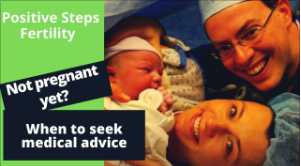Sexually transmitted diseases are running rampant, causing infertility in the process. This may seem scary, but we are specially equipped to find and address STD-related infertility, even if it happened a long time ago.
It is ironic that the more you’ve had sex in your past, the less fertile you may be, particularly if condoms weren’t used. Sexually transmitted diseases (STDs) can make both women and men infertile, though it seems to affect women more. Up to 85 percent of women that have had chlamydia don’t realize they’ve had it.
Moreover, the South (particularly Mississippi) has some of the highest rates of STDs in the United States. Other areas of the U.S. with high rates of infections include Alaska, Washington, D.C. and the U.S. Virgin Islands (which may need a new name based on these statistics).
STDs can not only affect mothers and fathers, but even their children (e.g. chlamydial conjunctivitis). A single event of pelvic inflammatory disease (PID) can cause 20 percent of women to have blocked fallopian tubes, as well as a 20 percent rate of chronic pelvic pain. Even if the fallopian tubes aren’t completely closed, they can still have damage that can be missed. We’re fortunate at Positive Steps Fertility to provide our Parryscope™ fertility evaluation that thoroughly examines the fallopian tubes, as well as uterine health and ovarian reserve, often picking up problems other doctors have missed.
Related information: Having trouble getting pregnant? Whether due to STDs or other causes, we can help. So please make an appointment.
There are three basics to understanding how STDs and fertility overlap: what STDs are, how they cause infertility and how to fix problems.
What are sexually transmitted diseases?
An STD is one that is passed from one person to another mainly through intimate sexual contact, which can be “heavy petting,” vaginal or anal sexual intercourse, and oral sex. There are dozens of STDs including syphilis, gonorrhea, chlamydia, herpes, human papillomavirus (HPV) and others. But gonorrhea and chlamydia are the ones most likely to cause subfertility (reduced fertility).
Most sexually active people are familiar with the term STD, and probably STI (sexually transmitted infection). The terms are often used interchangeably. But technically the sexually transmitted infection occurs before the sexually transmitted disease, which follows from the infection. STI or STD, you don’t want either one.
About 20 million new cases of STDs occur every year, according to the Centers for Disease Control and Prevention (CDC). And roughly 75 percent of women will get some type of STD in their lifetime (over 90 percent if you include HPV). STDs are most common in women under age 25, and up to 80 percent of women with chlamydia get it between age 15 and 25.
According to the CDC, there were a record number of cases in 2016 for gonorrhea, chlamydia and syphilis. Though we hope for these numbers to drop for subsequent years (there’s a delay in release of data due to analysis), decreased government funding for health centers has already led to increased costs for testing in several areas, resulting in fewer people getting evaluated.
This means more people with infections won’t know they have one, and a greater likelihood of STDs being spread. Based on past parallels, we expect more women to have STIs in the future, particularly in areas with limited investment in public health.
The best practice, particularly for people trying to get pregnant, is to be tested for STDs (CDC guidelines for testing) and get treated if an STD is present. Mississippians particularly should be on guard for STDs. According to the CDC, the state ranks #1 in gonorrhea, #3 in chlamydia and #7 in primary and secondary syphilis.
How STDs cause infertility
Gonorrhea and chlamydia, which are preventable, are the two STDs most likely to result in infertility because they can cause PID in women. This can inflame and scar the fallopian tubes, making it hard for sperm and eggs to find each other, blocking pregnancy. Chlamydia and gonorrhea can also cause inflammation of the cervix and inflammation of the urethra in the lower part of the urinary tract.
Gonorrhea and chlamydia often show no symptoms, so that’s another concern and reason to be tested. If untreated, about 15 percent of women with chlamydia will develop PID, which occurs in the upper part of the genital tract affecting the uterus, fallopian tubes and surrounding tissues in those areas. This can cause infertility, with cases of acute PID being particularly damaging to fertility.
Screening for gonorrhea and chlamydia is simple and inexpensive, involving a urine sample. Treatment is also relatively easy. The CDC recommends dual therapy of two drugs, one an injection, the other an oral medication. Because gonorrhea and chlamydia often occur at the same time, this dual approach can cure both.
HPV and herpes simplex virus (HSV) don’t directly cause infertility, but HSV can make you more vulnerable to other infections. Couples with HSV must abstain from sex until the sores have healed, and HPV can progress to cervical (and other) cancer, and the treatments can sometimes make you less fertile.
STDs in men
Though STDs are more detrimental to female fertility, if the male has gonorrhea or chlamydia, it can render him infertile because the infection can block the epididymis. These are the long, coiled tubes at the back of the testicles that store and then carry sperm during ejaculation. A blocked epididymis can mean that no sperm gets to the female’s eggs during intercourse. Men who suspect they are having trouble should come to us and have their fertility assessed.
But the most likely way that a male STD can cause infertility is that he passes the disease to his female partner. Then she becomes infertile, as described above. The male partner’s STD could also affect fertility by causing the couple to abstain from sex in order to heal and not spread the disease.
Working around STD-caused infertility
For men and women seeking to have children, the biggest issue with STDs is damage to the woman’s fallopian tubes and potentially even the uterus. The two fallopian tubes pick up eggs from the ovaries, so if the tubes are closed at that end from a previous infection, there won’t be many (or any) eggs for the sperm to find and fertilize in order to make an embryo.
Also, even if the tubes are only partially blocked, and sperm and egg “get lucky” finding each other, the damage can still prevent an embryo from making it back to the uterus, resulting in an ectopic pregnancy, which is a dangerous condition, and the pregnancy must be ended. Additionally, very bad pelvic infections can scar the uterus, resulting in Asherman’s syndrome, making it difficult for an embryo to attach or develop.
With the Parryscope™ technique I invented and for which I have a patent and trademark pending, we can quickly, gently and accurately look at whether the fallopian tubes are open or whether STDs (or other factors) may have resulted in scarring. At the same time we can also look at ovarian and uterine factors, so as to cover the core factors in female fertility.
If there is a blockage in the fallopian tubes or other problems are found, additional evaluation and treatment may be necessary. Though the Parryscope™ technique is a minimally invasive surgical service through hysteroscopy, the focus is on diagnostic evaluation. Other minimally invasive surgeries such as laparoscopy may be necessary to repair the tubes.
We perform such surgeries at Positive Steps Fertility. These therapies can include a salpingostomy procedure that can clear a new opening in a blocked fallopian tube near the ovary. Another option is a fimbrioplasty operation, which can rebuild the fringe-like ends of the fallopian tube by the ovary that serve to sweep the egg into the tube from the ovary. For blockages of the tubes near the uterus, we can attempt to clear them with tubal cannulation, in which we use a catheter through the cervix and uterus to try to clear the blockage
If these aren’t options or are not successful, we have to bypass the fallopian tubes to achieve pregnancy. This is where assisted reproductive technologies come into play, and in vitro fertilization (IVF) is often the best choice.
If only one fallopian tube is blocked, pregnancy is still possible. We may be able to assist it with intrauterine insemination (IUI).
Three closing thoughts on STDs and infertility for people trying to have children
- You should try your best to prevent getting an STD.
- If you think it’s possible you have an STD, be tested and have it treated.
- If you suspect an STD – or anything – is preventing you from getting pregnant, get in touch with me: We’ll find out the problem and work around it the best way possible.




